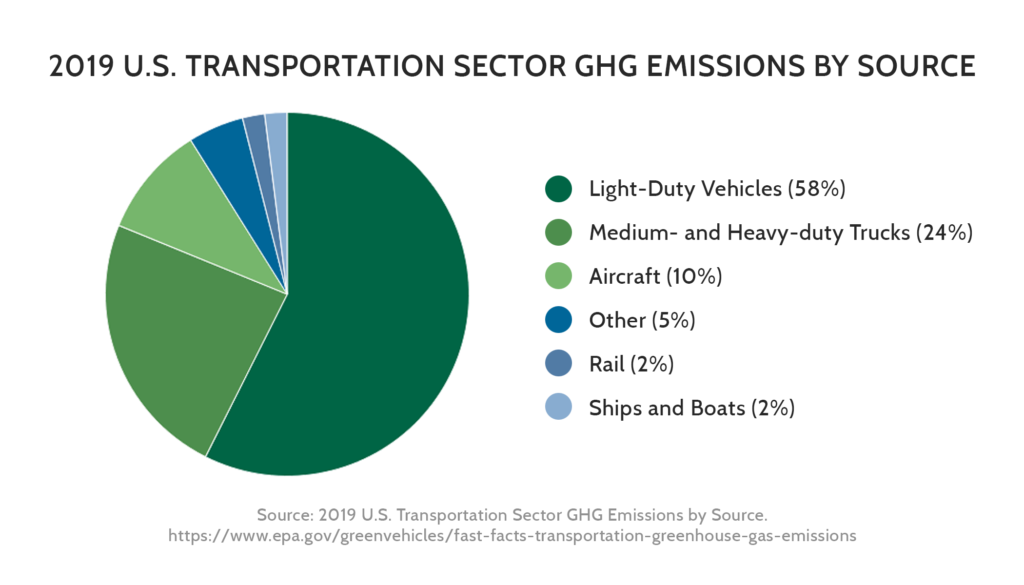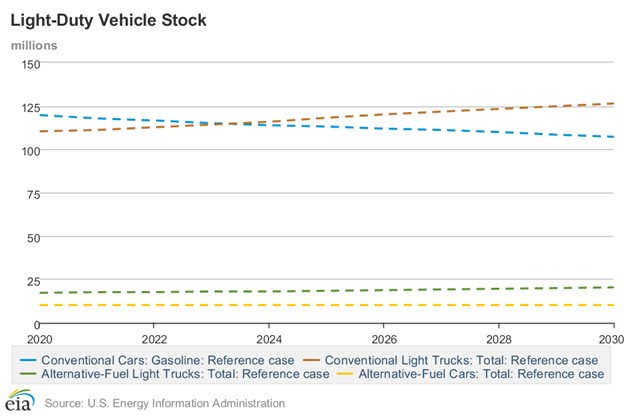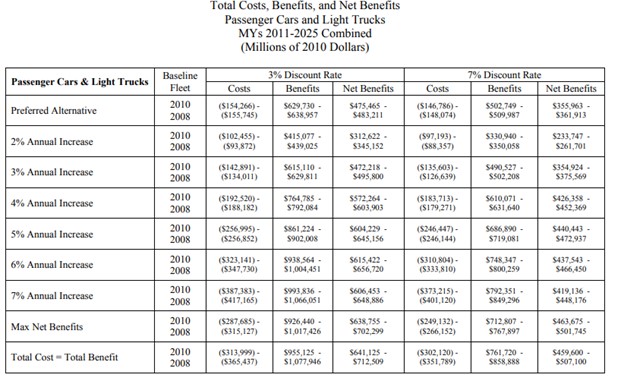Insight
June 16, 2021
Examining the NDC: Transportation Emissions
Executive Summary
- Greenhouse gases from transportation sources represent the largest source of emissions by sector in the United States, and reducing these emissions is necessary for the Biden Administration to reach its goal stated in the Nationally Determined Contribution (NDC).
- This analysis considers possible new regulation on light-duty vehicles, medium and heavy-duty vehicles, and aviation.
- While there is room to reduce emissions from the transportation sector, this analysis finds that more stringent regulations in these three areas would be costly to comply with, possibly infeasible, and insufficient to meet the administration’s NDC objectives.
Introduction
On Earth Day, the Biden Administration notified the United Nations about how it intends to reduce greenhouse gas emissions in the United States, which was necessary following the country’s re-joining of the Paris Agreement on climate change. This brief document, known as the Nationally Determined Contribution (NDC), set an economy-wide target of reducing greenhouse gas emissions by 50-52 percent from 2005 levels by 2030. The document approaches emissions reductions on a sector-by-sector basis, and the American Action Forum is releasing a series of analyses following that same sector-by-sector approach. The first analysis explored a potential regulatory scheme the administration could rely on to reduce emissions in the electricity generation sector, including possible abatement potentials and costs. The second analysis examined similar potentials from further regulation of methane emissions from the oil and natural gas industries.
This analysis focuses on the transportation sector – specifically emissions from light-duty vehicles, medium and heavy-duty vehicles, and aviation (aircraft). Emissions from transportation are the largest source of greenhouse gases by sector, according to the Environmental Protection Agency (EPA), and motor vehicles and aircraft are the largest contributors to transportation emissions, making up 92 percent. The chart below shows sources of transportation emissions and their share of contribution.
While there is room to reduce emissions from the transportation sector, this analysis finds that – similar to the previous analyses in this series – more stringent regulations would be costly to comply with, potentially infeasible, and insufficient to meet the administration’s NDC objectives.
Light-Duty Vehicles
Proposed Rules
The core of any transportation emissions reduction program will center on light-duty vehicles, which as the graph above shows make up nearly 60 percent of all transportation-related emissions. The NDC does not, however, set a quantified goal for this sector, but instead qualitatively notes:
Policies that can contribute to emissions reduction pathways consistent with the NDC include: tailpipe emissions and efficiency standards; incentives for zero emission personal vehicles; funding for charging infrastructure to support multi-unit dwellings, public charging, and long-distance travel; and research, development, demonstration, and deployment efforts to support advances in very low carbon new-generation renewable fuels for applications like aviation, and other cutting-edge transportation technologies across modes.
This analysis examines the first of those policy paths: regulating the fuel efficiency of light-duty vehicles and thus the level of emissions coming from those vehicles via Corporate Average Fuel Economy (CAFE) standards.
Light-duty CAFE standards rules have historically been among the most economically consequential rulemakings. The last round of Obama-era standards produced that administration’s costliest rule. Conversely, the Trump-era revision of those standards yielded that administration its greatest estimated regulatory cost reductions.
Under current statute, the relevant agencies (the National Highway Traffic and Safety Administration [NHTSA] & EPA) could set standards for vehicles through model year (MY) 2030.[1] There have been limited hints as to what an updated set of CAFE standards could look like. In the Biden Administration’s recently released Unified Agenda of Regulatory and Deregulatory Actions, NHTSA includes an entry regarding “Passenger Car and Light Truck Corporate Average Fuel Economy Standards.” In the description of the potential rulemaking, the agency notes that “For model years 2021 to 2030, the average fuel economy required to be attained by each fleet of passenger and non-passenger automobiles shall be the maximum feasible for each model year.” This suggests that the Biden Administration has the goal of setting standards through MY 2030. The “maximum feasible” threshold does little to illuminate the exact scale of the potential standards, however, since that is merely the language included in the relevant statute.[2] Per the Unified Agenda listing, the administration currently expects a proposed rule on the matter to be published in July 2021.
Policy Considerations
Since, again, the NDC does not include a specific goal for emissions reductions for light-duty vehicles, it is difficult to extrapolate the exact monetary scale involved in such an exercise. One way to illustrate the scale of the factors involved is to look at which market trends would need to change under a given regulatory program. The following chart includes the Energy Information Agency’s (EIA) latest projections of the nation’s light-duty vehicle stock over the next decade.
As of this year there are an estimated 228.9 million “Conventional” (the fossil-fuel burning kind) trucks and cars versus only 27.4 million “Alternative” (those using non-carbon fuels) trucks and cars. By the end of the decade under current market conditions, EIA projects that balance to be 233.5 million “Conventional” vehicles versus 30.5 million “Alternative” vehicles. A future set of CAFE standards that provides any real contribution to the NDC’s overarching goal of cutting emissions roughly in half by 2030 would necessarily need to close that gap even more dramatically. Furthermore, as the EIA projections and other data show, the emerging market trend of increasing consumer preference for light trucks over sedans complicates the setting of more stringent standards since light trucks are, broadly speaking, inherently less efficient than sedans.[3]
Based on what is known from prior standards, doing so, especially with only a window of five model years to work with, could have profound economic impacts. The following table is from the analysis underlying the Obama-era standards.[4]
The bottom four alternatives, which would also have been the most rigorous, had estimated impacts at least double that of the “Preferred Alternative.” While the exact figures here cannot be prescriptive of what would happen under new standards given the vast difference in time, market dynamics, and regulatory provisions from the 2012 rule’s analysis, it does provide a sense of the order of magnitude involved in more stringent alternative standards.
In Practice
Beyond the natural constraints and challenges posed by setting exigent technology standards over a limited time window – a theme that has featured prominently over this series of analyses – there is also the unique interplay involving state-level actors and industry stakeholders in the light-duty vehicle market. A significant part of the Trump-era rulemakings on the topic involved attempts to preempt California in establishing its own standards. While the legal wrangling over that issue is largely over due to the change in administrations, there remains a tension between the effective state of play coming out of that back-and-forth and what establishing even bolder national standards may look like.
In 2019, a group of automakers entered into a deal with California establishing a set of standards “that fell roughly midway between the Phase 2 standards [Obama-era rule] and the Trump Administration’s proposal.” [5] In particular, this agreement involves a 3.7 percent year-over-year increase in stringency.[6] Per a recent press report on the topic: “It’s this deal that drew a line in the sand with various automakers; while the four sided with California, other major companies like General Motors, Stellantis, Toyota and Hyundai originally sided with the Trump administration. That has since changed, with most automakers now falling in line with California.”
The dilemma here, at least with regards to achieving an ambitious level of emissions reductions under the NDC, is how much farther beyond this new consensus would the relevant agencies have to go? While this deal is only on a state-level standard, given California’s prodigious market share, it could be the effective standard under which automakers plan their design strategies in coming years. A level of national standards that abruptly and severely changes those plans will likely bring greater opposition from industry stakeholders during the rulemaking process, if not eventual litigation. These complications would make an already-tight implementation window even tighter.
Medium and Heavy-Duty Vehicles
Though medium and heavy-duty vehicles (MHDVs) account for fewer emissions than light-duty vehicles, they still contributed 23 percent of transportation sector emissions in 2018, according to EPA. The NDC indicates that MHDVs would be good candidates for increased tailpipe emissions and efficiency standards, similar to light-duty vehicles.[7]
Unlike light-duty vehicles, however, regulation does not go back multiples decades. The first regulations on MHDVs were promulgated in 2011, and covered MYs 2014-2018. A second set of regulations, known as Phase 2, were published in 2016 and span MYs 2019-2027. The Phase 2 rule required average annual fuel efficiency increases of 2.5 percent through 2027. The strictest alternative considered at the time, a 4 percent per-year improvement that may serve as a guide for future regulation, was not adopted because EPA and DOT determined it was not technically feasible and “would result in a decrease in the in-use reliability and durability of new heavy-duty vehicles.” EPA did not provide a full cost projection of this alternative since it was not a realistic option, but those costs that it did project show that costs were about 79 percent higher than the adopted option (while benefits were about 38 percent higher).[8]
Over the past five years, some of those attributes considered unattainable in 2016 have become more realistic, including better batteries and the possibility of improved charging infrastructure. This makes EPA and DOT more likely to pursue a stricter regulatory option to help achieve its NDC goals. Despite these improvements, the agencies face other legal hurdles that prevent timely adoption of more stringent regulations in the near term.
EPA and DOT could consider revising the Phase 2 regulations so that a more stringent reduction improvement goes into effect prior to MY 2028. The law authorizing DOT’s part of the rule, however, requires at least four years before the requirements are mandatory (the agencies could make the requirements voluntary as it did for the first two years of the first MHDV rule, but unless equipment manufacturers can cost-effectively meet the standards, it would not have the needed effect). The result is that, even in a best-case scenario where the rule is published sometime in 2022, only MY 2027 would be covered with mandatory standards.
The agencies are likely to issue stronger requirements as part of its Phase 3 rule, which would cover MYs 2028 and beyond.[9] That rule would have little impact on 2030 emissions targets, however, since it would cover just the three years prior to the target year. Further, the rules apply to newly manufactured equipment, so the vast majority of the MHDVs in use would be older models. If Phase 3 rules are excessively expensive, that could also dampen uptake of the new equipment, leaving older, less efficient MHDVs in use beyond when they otherwise would have been replaced.
Aviation
The aviation sector is often mentioned as significant source of greenhouse gas emissions. According to EPA, as of 2018 aircraft accounted for 9 percent of emissions from transportation sources. Compared to light and heavy-duty motor vehicles, the NDC is far vaguer in its description of what steps the United States will take to reduce emissions from the sector. Beyond research and development of low-carbon fuels, the NDC merely promises to explore “ways to support decarbonization of…aviation energy use through domestic action.”[10]
The EPA finalized updated emissions standards for airplane manufacturers in January 2021. That rule, which was relatively uncontroversial, adopted the International Civil Aviation Organization’s 2017 standards for carbon dioxide emissions that applied to newly designed airplanes and those in production. Standards on new designs are already in effect, while those on most in-production planes apply in 2028.
Despite a tendency to prefer strengthening existing carbon emissions rules in many areas, the Biden Administration appears to have little appetite for revisiting aviation standards – there is no mention of airplane emissions standards in the recently released Unified Agenda. For one reason, the standards are still new and have yet to go fully into effect and there appears to be limited eagerness to go beyond the international levels agreed to under the Obama Administration.
A second reason is that a more stringent alternative is not cost effective. In developing the 2021 rule, the EPA considered an option that would have accelerated the timeline for compliance with the in-production standard and made that standard more stringent. Such a rule would have applied to only one additional type of aircraft and have costs that exceed the benefits by between $261 million and $285 million.[11]
Though the NDC mentions reducing emissions from the aviation sector, any real reduction in emissions will likely have to happen through legislative mandate rather than more stringent regulation under existing authority. Even with legislation, the likelihood it would have any material impact on emission levels by 2030 seems remote.
Conclusion
A review of possible new regulatory schemes covering greenhouse gas emissions from the transportation sector finds that, under existing authorities, such schemes would be insufficient to meet the NDC’s goal of a 50-52 percent reduction from 2005 levels by 2030. The largest room for reduction lies in the light-duty vehicle sector, however, new standards that would be sufficient to meet the 2030 goal may not be feasible and would likely trigger strong opposition from some vehicle manufacturers. Similarly, new regulations on MHDVs and aircraft would be unlikely to make an impact by 2030 and may also not be technically feasible.
[1] National Academies of Sciences, Engineering, and Medicine 2021. Assessment of Technologies for Improving Light-Duty Vehicle Fuel Economy 2025-2035. Washington, DC: The National Academies Press. p. 13-420.
[2] National Highway Traffic Safety Administration. Corporate Average Fuel Economy for MY 2017-MY 2025 Passenger Cars and Light Trucks, Final Regulatory Impact Analysis. August 2012. p. 3.
[3] Lattanzio, et al. Vehicle Fuel Economy and Greenhouse Gas Standards: Frequently Asked Questions. June 1, 2021. pp. 13-14.
[4] National Highway Traffic Safety Administration. Corporate Average Fuel Economy for MY 2017-MY 2025 Passenger Cars and Light Trucks, Final Regulatory Impact Analysis. August 2012. p. 13.
[5] Lattanzio, et al. Vehicle Fuel Economy and Greenhouse Gas Standards: Frequently Asked Questions. June 1, 2021. p. 26.
[6] Ibid.
[7] The United States’ Nationally Determined Contribution Reducing Greenhouse Gases in the United States: A 2030 Emissions Target. April 2020. p. 4.
[8] U.S. Environmental Protection Agency and Department of Transportation. Greenhouse Gas Emissions and Fuel
Efficiency Standards for Medium and Heavy-Duty Engines and Vehicles – Phase 2, Regulatory Impact Analysis. August 2016. pp. 11-21 – 11-24 (Tables 11-16 – 11-19).
[9] National Academies of Sciences, Engineering, and Medicine 2020. Reducing Fuel Consumption and Greenhouse Gas Emissions of Medium and Heavy-Duty Vehicles, Phase Two: Final Report. Washington, DC: The National Academies Press.
[10] The United States’ Nationally Determined Contribution Reducing Greenhouse Gases in the United States: A 2030 Emissions Target. April 2020. p. 4.
[11] U.S. Environmental Protection Agency. Airplane Greenhouse Gas Standards Technical Support Document. December 2020. p. 148 (Table 6-13).














